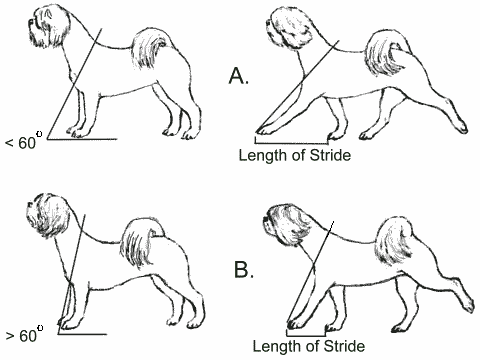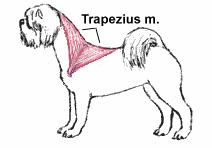Angulation and Movement in the Lhasa Apso
by
Catherine Marley, M.D.
Analysis
of angulation and movement in the Apso is greatly complicated by coat.
Examination of the dog in the ring requires a discerning eye
to subtract the confusion of a profuse coat and visualize the dog
underneath. Perhaps these few anatomical observations will help.

First, let's examine the
diagrams. "A" is
our
ideally angulated Apso. The shoulder blade is set on the body at about
60 degrees relative to the ground. It articulates with the upper arm at
about 100 degrees and is angled to the neck at a similar angle. Maximum
reach depends on the shoulder angulation. In maximum extension of the
forelimb,
the shoulder blade rotates an additional 10 - 15 degrees by contraction
of muscles in the neck and upper back, acheiving a total angle near 45
degrees, which provides a maximum length of foreleg stride.
Now examine our
poorly angulated Apso, "B."
This
dog has poor "shoulder layback." Its shoulder is laid back at an angle
greater than 60 degrees with the horizontal. This dog does, however,
possess
good rear angulation. (More about that later.)
Right off, we can see certain
things about "B"
in
comparison to "A." First, because its shoulder angle is steep, the
entire
forehand assembly is placed more anteriorly on the dog. This anterior
placement
of the shoulder causes the illusion of a long neck, and a short back.
In
fact what appears to be neck often actually includes 4 to 8 thoracic
vertebrae.
In movement this becomes evident. Strong muscles originating on the
head
and neck participate in movement by supplying lift to the
scapulo-humeral
joint. This is what gives the additional 10 to 15 degrees of rotation
of
the shoulder blade mentioned above. The steep shouldered dog must lower
his head and carry it closer to the horizontal, so that those muscles
will
have the mechanical advantage necessary to rotate the shoulder blade.
If
the dog is "strung up", The stride can be lengthened by suspension of
the
front end, but the shoulder will not rotate, and the front will be seen
to "hackney".
 Good
"layback" provides better balanced support to the musculature -
particularly
to the trapezius muscle. This is a large flat muscle, the upper half of
which connects the cervical vertebrae of the neck to the upper half of
the scapula, and the lower half of the trapezius connects the lower
half
of the scapula to the thoracic vertebrae. The upright shoulder blade
does
not offer much support to the spinal column, and there is a consequent
tendency in these dogs to a sagging topline - quite marked in some
cases.
Good
"layback" provides better balanced support to the musculature -
particularly
to the trapezius muscle. This is a large flat muscle, the upper half of
which connects the cervical vertebrae of the neck to the upper half of
the scapula, and the lower half of the trapezius connects the lower
half
of the scapula to the thoracic vertebrae. The upright shoulder blade
does
not offer much support to the spinal column, and there is a consequent
tendency in these dogs to a sagging topline - quite marked in some
cases.
Articulation
of the shoulder blade with the
upper
arm in "B" is at an angle of 130 degrees or more. This flattening of
the
"point of shoulder" can easily be palpated on dogs with straight
shoulders.
When
we look at the diagram of "B" in movement,
we
see that the mechanics of the upright shoulder dictate that maximum
extension
of the forelimb results in a shortened stride. To compensate for this,
the dog may "hackney," bending its elbows and lifting its forefeet high
off the ground, often assisted to some extent, by "stringing up" the
animal.
This maneuver makes it possible for him to get a longer front stride by
suspending his front end in mid air while allowing the full driving
action
of the rear end. While this may minimize the "pounding," many dogs will
not tolerate being strung up, and respond by gagging and pulling.
Coming back to
diagram B, a problem in rear
movement
can be seen, resulting from the short front reach. Dog B has the same
rear
angulation as dog A. However if he used his rear to the same extent as
dog A, his rear would out-drive his front and the dog would fall right
on his nose. The dog with a poor front and good rear angulation must
shorten
the reach of the rear leg under the body so that his rear stride will match the front. The problem then becomes: what to
do
with all that rear angulation and power? One solution is an exaggerated
high-kick in the rear. The power which cannot be used for propulsion
because
of a shortened front reach is now expended into the air.
This particular movement is
often very flashy,
especially
from the rear. Those rear skirts are flipped rapidly high up the back,
giving the impression of a "super driving" rear. Closer attention to
the
over all forward progress of the dog will reveal that this type of
"driving"
is largely wasted motion, contributing little toward the business of
moving
the animal forward. One clue to the presence of this kind of "rear
over-drive"
is that the rear quarters of such animals will often show excessive
vertical
(up and down) movement.
The reverse of dog "B" is
an animal with a well
angulated
front and a poorly angulated rear. Many of these will appear high in
the
rear and will have a "mincing" gait. This dog must shorten his front
stride
to match a short rear stride. He may move fast, but only by taking many
steps very quickly. This kind of movement may be quite smooth and it is
difficult to detect if the dog carries a lot of coat. A tip-off will be
a real lack of noticeable activity in the rear end.
The dog who is straight in
front and rear may
also
move very well except that his head carriage (the set-on of the neck)
will
often reveal the presence of straight shoulders. This type of dog may
also
bounce up and down a good deal, front and rear, as the dog attempts to
gain speed by leaving the ground as much as possible.
Coming back to our ideal dog
A: this dog will
move
smoothly and effortlessly on a loose lead with the head extended at
about
45 degrees to the body axis. There will not be excessive kick up in the
rear, nor much vertical movement front or rear. From the side, the dog
will appear to flow forward with long effortless smooth strides.
Remember
that this is a dog of high altitude, where oxygen is scarce. Any animal
whose conformation causes him to expend a great deal of effort in order
to move would not survive. The essence of the Apso is it's
fitness to the environment of Tibet.

 Good
"layback" provides better balanced support to the musculature -
particularly
to the trapezius muscle. This is a large flat muscle, the upper half of
which connects the cervical vertebrae of the neck to the upper half of
the scapula, and the lower half of the trapezius connects the lower
half
of the scapula to the thoracic vertebrae. The upright shoulder blade
does
not offer much support to the spinal column, and there is a consequent
tendency in these dogs to a sagging topline - quite marked in some
cases.
Good
"layback" provides better balanced support to the musculature -
particularly
to the trapezius muscle. This is a large flat muscle, the upper half of
which connects the cervical vertebrae of the neck to the upper half of
the scapula, and the lower half of the trapezius connects the lower
half
of the scapula to the thoracic vertebrae. The upright shoulder blade
does
not offer much support to the spinal column, and there is a consequent
tendency in these dogs to a sagging topline - quite marked in some
cases.